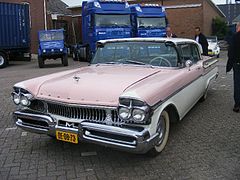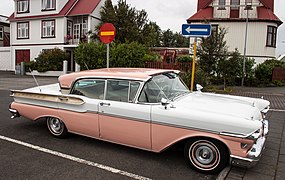
The Chevrolet Bel Air is a full-size car produced by Chevrolet for the 1950–1981 model years. Initially, only the two-door hardtops in the Chevrolet model range were designated with the Bel Air name from 1950 to 1952. With the 1953 model year, the Bel Air name was changed from a designation for a unique body shape to a premium level of trim applied across a number of body styles. The Bel Air continued with various other trim level designations, and it had gone from a mid-level trim car to a budget fleet sedan when U.S. production ceased in 1975. Production continued in Canada, for its home market only, through the 1981 model year.

The Oldsmobile 98 is the full-size flagship model of Oldsmobile that was produced from 1940 until 1942, and then from 1946 to 1996. The name – reflecting a "Series 90" fitted with an 8-cylinder engine – first appeared in 1941 and was used again after American consumer automobile production resumed post-World War II. It was, as it would remain, the division's top-of-the-line model, with lesser Oldsmobiles having lower numbers such as the A-body 66 and 68, and the B-body 76 and 78. The Series 60 was retired in 1949, the same year the Oldsmobile 78 was replaced by the 88. The Oldsmobile 76 was retired after 1950. This left the two remaining number-names to carry on into the 1990s as the bread and butter of the full-size Oldsmobile lineup until the Eighty Eight-based Regency replaced the 98 in 1997.

The Mercury Montclair is a series of full-size sedans that were manufactured and marketed over five generations by the Mercury division of Ford. The nameplate was used by the division twice, from the 1955 to the 1960 model years and from the 1964 to the 1968 model years. The model was offered as two-door and four-door hardtops, four-door pillared sedan, and a two-door convertible.

The Mercury Park Lane is a full-sized automobile that was produced by the Mercury division of Ford Motor Company. While not officially introduced as the replacement of the Mercury Turnpike Cruiser, the Park Lane became the flagship of the Mercury model line upon its introduction. The second-generation Park Lane was positioned above the Mercury Montclair.
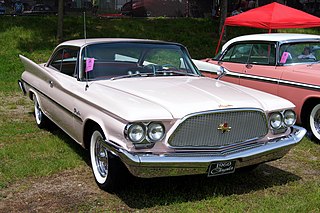
The Chrysler Windsor is a full-size car which was built by Chrysler from 1939 through to the 1960s. The final Chrysler Windsor sold in the United States was produced in 1961, but production in Canada continued until 1966. The Canadian 1961 to 1966 Windsor model was for all intents and purposes the equivalent of the Chrysler Newport in the United States.

The Mercury Colony Park is an American luxury full-size station wagon that was marketed by the Mercury division of Ford Motor Company between 1957 and 1991. Distinguished by its simulated wood-grain paneling, the Colony Park was marketed as either the premium-trim or the sole full-size station wagon offering of the division. Following the 1960 demise of Edsel, full-size Mercury vehicles shared bodywork with Ford; the Colony Park served as the counterpart of the Ford Country Squire through 1991.

The Mercury Marquis is a model line of automobiles marketed by Mercury from 1967 to 1986. Deriving its name from a title of French nobility, the Marquis was introduced as the divisional counterpart of the Ford LTD; four generations of the two model lines were paired through rebranding. Initially slotted as the flagship Mercury full-size range, the Marquis would serve as the basis for the later Mercury Grand Marquis.

The Lincoln Cosmopolitan is a full-size luxury car that was sold by Lincoln from the 1949 through the 1954 model year. All Lincolns were manufactured at Lincoln Assembly, Dearborn, Michigan, while some were sent in "knock-down kits" to regional factories at Maywood Assembly, Maywood, California or St. Louis Assembly, St.Louis, Missouri, and assembled locally.
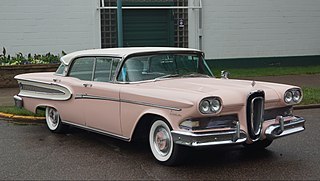
The Edsel Citation is an automobile that was produced by the Edsel division of Ford for the 1958 model year. The flagship Edsel model line, the Citation was offered as a two-door convertible; all Citation sedans were produced as hardtops. Slotted above the Corsair, the exterior of the Citation was distinguished by additional stainless steel trim and a gold-anodized aluminum cove panel.
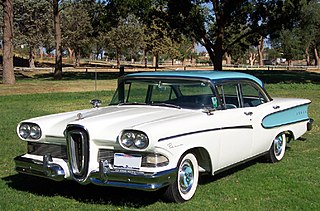
The Edsel Pacer is an automobile that was produced and sold by Edsel in 1958. The Pacer was based on the shorter narrower Edsel platform, shared with Ford and the Ranger.

The Edsel Ranger is an automobile that was produced and sold by the newly formed Edsel Division of Ford for the 1958–1960 model years. It was built on the shorter, narrower Edsel platform, shared with Ford and Edsel Pacer models.

The Mercury Eight is an automobile that was produced by the American manufacturer Ford Motor Company under their now defunct division Mercury between 1939 and 1951. The debut model line of the Mercury division, Ford positioned the full-size Mercury Eight between the Ford Deluxe model lines and the Lincoln. In total, Ford assembled three generations of the Eight.

The Ford line of cars was again refreshed for 1952, although remaining similar to the all-new 1949 Fords. This time, curved one-piece windshield glass joined a new "Mileage Maker" straight-6 engine with 101 hp. The 226 CID (3.7 L) L-head straight-6 was replaced by an overhead valve 215 CID (3.5 L) Mileage Maker with 101 hp (75 kW), while the old 239 CID (3.9 L) Flathead V8 remained with 110 hp (82 kW). This design would continue through the 1954 model year, with an updated design offered in 1955.

The 1955 Ford is an automobile which was produced by Ford in the United States for the 1955 model year and, in revised form, for the 1956 model year. A new design would be offered in 1957.

The Mercury Monterey is a series of full-size cars that were manufactured and marketed by the Mercury division of Ford from 1950 to 1974. Deriving its name from Monterey Bay, the initial Mercury Monterey served as the top-of-the-line two-door sedan model for 1950 and 1951 to compete with the hardtop models of Oldsmobile and Buick. It came with a vinyl roof covering, upgraded upholstery, and other features. The hardtop was introduced for 1952. During its production, the Monterey would be offered in multiple body styles, ranging from coupes, convertibles, sedans, hardtops, and station wagons.
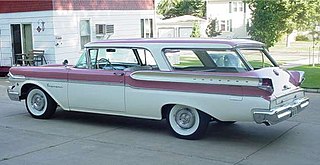
The Mercury Voyager is a station wagon that was sold by the Mercury division of Ford for the 1957 and 1958 model years. For the 1957 model year, Mercury created a model range of station wagons distinct from sedans, following Ford. The Voyager served as the mid-range offering, slotted above the base-trim Mercury Commuter, with the woodgrained Colony Park serving as the top-range offering.

The Mercury S-55 is a full-size car that was marketed by the Mercury division of the Ford Motor Company during the 1960s. Developed as a performance-oriented version of the mid-level Mercury Monterey, the S-55 was the largest vehicle of the Mercury "S" (Special) range introduced in 1962; its Ford equivalent was the Ford Galaxie 500XL and competed in the full-size luxury sport coupe market segment against the Chrysler 300H.

The Lincoln EL-Series is a full-size luxury car that was marketed and sold by Lincoln from 1949 to 1951. Replacing the H-Series Lincoln, the postwar model line was the first complete redesign of the Lincoln sedan line since 1936. In line with its predecessor, the EL-Series Lincoln carried only the Lincoln nameplate, using no divisional branding; the Lincoln was slotted below the Lincoln Cosmopolitan within the Lincoln model range.

The Mercury Marauder is an automobile nameplate that was used for three distinct full-size cars produced by the Mercury division of Ford Motor Company. Deriving its name from the most powerful engines available to the Mercury line, the Marauder was marketed as the highest-performance version of the full-size product range.

Breezeway is a term for a vertical or reverse-slanted, power-operated retractable rear window on sedans. Intended to provide through ventilation, it first appeared on the 1957-1958 Mercury Turnpike Cruisers and the 1958–1960 Continental Mark III, IV, & V. After a break it reappeared on some 1963–1968 full-size Mercurys, including some Park Lanes, Montclairs, and Montereys.



